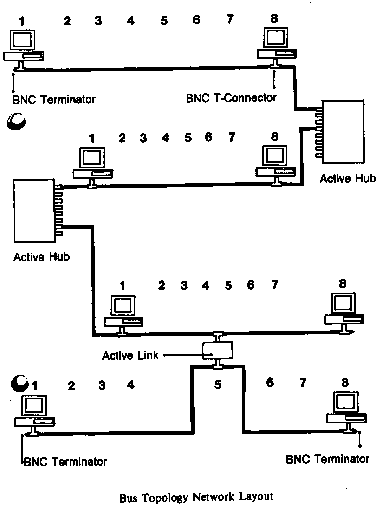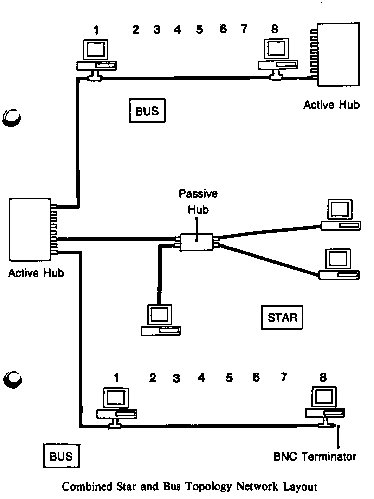
Installing the Network
ARCnet is an extremely easy-to-install LAN since it offers a flexible
topology with few limitation. It can be configured as a simple Star or Bus topology network, or a
Combined Star and Bus topology network.
The ARCnet card is equipped with a standard BNC
female connector (see figure below) for connection to RG-62 A/U
coaxial cable.

Star Topology Network
To install a star network, here are the hardware requirements.
- ARCnet Card
- The ARCnet network card must have a low impedance driver hybrid
(SMC 9068).
A low impedance hybrid is equivalent to a high impedance driver hybrid and
terminator.
- Cable
- The ARCnet network uses the RG-62 A/U 93-ohm coaxial cable with
BNC male connectors at both ends. It is used to
connect a network station, Passive Hub or Active Hub.
- Passive Hub
- The Passive Hub has four ports with four BNC
female connectors to connect a network station or Active Hub. It
is used to relay network signals. Any unused port on the Passive Hub
must be terminated with a 93-ohm BNC Terminator.
- Active Hub
- The Active Hub consists of eight ports with eight BNC female connectors to connect a network station,
Passive Hub or Active Hub. It is used to relay network signals and
amplify network signal strength. It is recommended that any unused
port on the Active Hub be terminated with a 93-ohm BNC Terminator,
however, it is not required.
- BNC Terminator
- The BNC Terminator is equipped with a 93-ohm resistor and is
usually installed on the Passive or Active Hub. It is used to prevent
the network transmissions from being interfered by reflections.
Installation Rules
While the ARCnet has been designed for maximum flexibility and ease of
installation, the installation rules for a star topology network
layout using low-impedance network cards must be borne in mind and are
detailed below:
- A Passive Hub is mainly used as intermediate connections
between stations and Active Hubs. To connect Passive Hubs in series
is not allowed since the Passive Hubs only relay network signals but
cannot strengthen the signals, otherwise the signal will be too weak
to transmit data.
- Any unused port on the Passive Hub must be
terminated with a 93-ohm BNC Terminator.
- Maximum distance between a Passive Hub and a station: 30 meters (100 feet)
- Maximum distance between a Passive Hub and an Active Hub: 30 meters (100 feet)
- An Active Hub can be connected to stations, Passive Hubs, and
another Active Hubs.
- Maximum distance between an Active Hub and a station: 600 meters
(2,000 feet)
- Maximum distance between Active Hubs: 600 meters (2,000 feet)
- It is recommended that any unused port on the Active Hub be
terminated with a 93-ohm BNC Terminator, but it is not required.
- Maximum distance from one end of the network to the other end:
6,000 meters (20,000 feet)
- Do not create a loop, i.e., a cable coming from a hub travels
through other hubs and connects back t the original hub.

Bus Topology Network
The bus ARCnet network uses a common bus line called Trunk Cable to
link stations together. The Trunk Cable can consist of one or many
Segments. A Segment is defined as a cable length consisting of a
number of Sections, and terminated at each end by a BNC Terminator. Every two segments are
linked together via an Active Link. A Section refers to the cable
length between two Tee-connectors (stations).
To install a bus network, here are the hardware
requirements.
- ARCnet Card
- The ARCnet network card must have high-impedance driver hybrid
(SMC 9058).
- Tee-Connector
- The Tee-Connector contains one BNC mate connector (to connect to
ARCnet card), and two BNC female connectors (to connect to a cable or
BNC Terminator).
- Cable
- The ARCnet network uses the RG-62 A/U 93-ohm coaxial cable with
BNC male connectors at both ends. It is used to connect two network
stations or an Active Link.
- BNC Terminator
- The BNC Terminator is equipped with a 93-ohm resistor and is
usually installed on the active hub or at the end of a bus network
segment. It is used to prevent the network transmissions from being
interfered by reflections.
- Active Link
- The Active Link has two ports with two BNC female connectors to
connect two bus network segments.
Installation Rules
While the ARCnet has been designed for maximum
flexibility and ease of installation, the installation rules
for a bus topology network layout using high-impedance
network cards must be borne in mind and are detailed
below:
- Connect a station to a cable via a Tee-connector.
- Do not use any cable between a station and a Tee-connector.
- It is not allowed to use the Passive Hubs on a bus topology
network.
- Minimum distance (section) between two Tee-connectors: 1 meter
(3 feet)
- Maximum number of stations in a bus network segment: 8
- Maximum distance of a bus network segment: 300 meters (1,000
feet)
- Both ends of a bus network segment must be installed with a
93-ohm BNC Terminator or an Active Hub.
- Maximum distance from one end of the network to the other end:
6,000 meters (20,000 feet)
- Do not create a loop, i.e., a cable coming from a hub travels
through other hubs and connects back to the original hub.

Combined Star and Bus Topology Network
The Combined Star and Bus Topology Network refers to the network
layout using the low-impedance and high- impedance ARCnet network
cards on the same network.
To install a combined star and bus topology network, you should have
the combinations of hardware requirements for star
and bus networks as described previously.
Installation Rules
In addition to the installation rules for star and bus
networks listed in earlier sections, the installation rules
for a combined star and bus topology network layout
must be observed.
- A bus network and a star network can be combined on the same
network by using an Active Hub.
- A bus network card (high-impedance) may
be connected to a hub in place of a low-impedance
ARCnet network card in a star network.
- The low-impedance ARCnet network cards are not allowed to place
in the middle of a series of high-impedance ARCnet network cards. They
can, however, be placed at the end of a cable segment instead of a
terminator.

ARCnet and SMC are registered trademarks.




